学術会合報告
ANZIAM 2018 参加報告
2018年04月26日
南畑 淳史, ランゲ マルコ
みなみはた あつし, らんげ まるこ
産業技術総合研究所,早稲田大学
ANZIAM 2018 概要
第54回 ANZIAM 2018はオーストラリアのタスマニア州ホバートにて行われました。会場はHotel Grand Chancellorであり、とても綺麗で眺めの良いホテルでした。
初めに、とても驚いたのが、ANZIAMは若い研究者がとても多いということでした。半分程度が若手と思われる人たちであり、ウェルカムパーティでは気軽に話しかけて頂いたりと、とても楽しく学会に参加する事が出来ました。
セッションはJSIAMのように研究部会で分けられているのではなく、厳密にジャンル分けというよりも近い分野の発表をまとめて、それ以外も時間があれば一緒のセッションで発表をするというスタイルでした。そのため、PDEの講演の後に時系列解析などジャンルが様変わりします。しかし、講演の間には移動時間が設けられており、聞きたい講演の場所にどんどん移動できたために、特に不自由を感じることはありませんでした。むしろ毎晩、”明日の講演はココに行って、これはどっちを聞こうかな…”と悩む楽しみがありました。
是非ともこの記事を読んでいる方はANZIAM2018のプログラムをご覧になって、この楽しさを体感してみてください。
次回、ANZIAM 2019はニュージーランドのNelsonという場所で開催されます。
日程も既に2月3日から2月7日と決まっておりますので、是非とも参加をご検討をいただきますよう宜しくお願い致します。
ANZIAMの思い出(by ランゲ マルコ)
個人的にANZIAM2018で最も思い出深い講演の一つとして、Nick Trefethen教授による講演を紹介したい。講演の内容は、誰もが聞いたことがあるファラデーケージの数理に関する講演であった。金網がどのようにして電場や電波を遮断するか、多くの人が直観的なアイディアを持っているかもしれない。しかしながら、その理解は本当に正しいのだろうか?金網の間隔が小さくなるにつれて、遮蔽効果はたかだか線形にしか改善されず、それは金網の半径に依存することが分かる。Nick Trefethen教授はこのようにファラデーケージの数理について興味深い講演をされ、皆の心を鷲掴みにされた。図1.と図2.はファラデーケージの現象とそのアナロジーについてのスライドである。
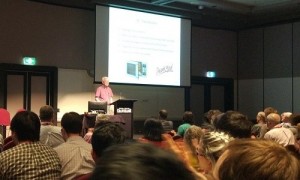
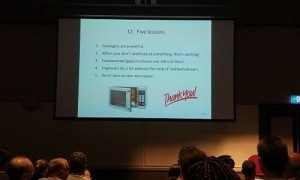
もう一つの興味を引かれたものとして、水曜日の午後のプレナリートークであったKate Smith-Miles教授の講演を紹介したい。これは、私の研究の内容との関連性ばかりではなく、彼女の研究の対象問題のスケールとそのプレゼンの方法にも興味を惹かれるものであった。講演は、魅惑的なタイトルからはじまった : “Optimization in the Darkness of Uncertainty: when you don’t know what you don’t know, and what you do know isn’t much!” この発表の中で取り扱っているのは多目的最適化問題であり、目的関数は数式では表せすことができないために、解析的な方法論に基づく計算方法は使用できない。更に、とても目的関数の評価にコストがかかり、十分な測定数を得る事が困難である。そのため、ランダムな試行実行は有効な方法となりえない。Kate Smith-Miles教授はブラックボックスの中での最適化問題に対して2つの戦略を紹介し、性能を評価するための方法の重要性を説いた。
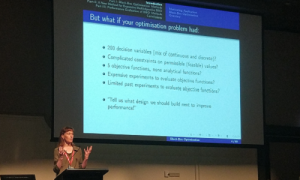

最後に面白かった学生の発表についても述べたいと思う。Sarah Beletさんは蚊の集団における共生細菌のWolbachiaの拡散に関するモデルを扱っていた。共生細菌であるWolbachiaの蚊の集団への広がりは特定の蚊を通じてデング熱の伝染を抑制する方法の導入となっている。私は、その鮮やかな説明に魅了された。細胞質不和合の現象と蚊の集団を通じたWolbachiaの拡散の講演は私の思い出深い講演の一つである。
ANZIAMでは数学、医学、工学などの異なる分野が協働し、共同研究している事に興味をそそられた。Sarah Beletさんの講演は分野横断の良い研究例だと思う。
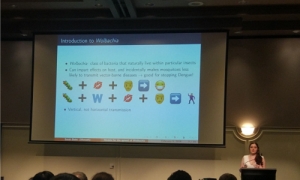
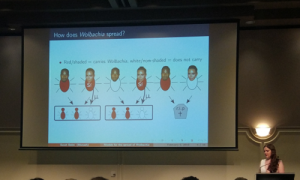
Memories from the ANZIAM conference(ANZIAMの思い出の原文)
Personally, one of the most memorial talks of the ANZIAM 2018 conference was the first plenary talk by Nick Trefethen. He spoke about the mathematics of the Faraday cage, something everybody has heard of. Surely, many of us have some intuitive idea on how a wire mesh is blocking electric fields and electromagnetic waves. But are our ideas really correct? It turns out that the shielding effect improves only linearly as the wire spacing decreases and that it depends on the wires having finite radius. Nick Trefethen gave a very interesting talk about this topic. The audience in the Grand Hall were caught in Nick Trefethen’s talk: the presentation of the Faraday cage phenomenon and also his lesson about analogies, see Figure 1 and 2.


Another presentation that caught my attention was the Wednesday afternoon plenary talk by Kate Smith-Miles. My interest in her talk is founded not only by the intersection with my own research topic but also by the scale of the problem and the way of its presentation. This starts already with the intriguing title: “Optimization in the Darkness of Uncertainty: when you don’t know what you don’t know, and what you do know isn’t much!” The presented optimization problem is a constrained multi-objective problem with no analytical expression for the objective functions. Calculus for analytically solutions cannot be used. Moreover, due to the high expense of evaluating the objective function, we have to limit the number of measuring points. Random trials are too expensive to be a valid option. Kate Smith-Miles introduced two strategies for black-box optimization and made the audience aware of the importance of methods for evaluating their performance.


Finally, I want to mention an interesting student talk. Sarah Belet was concerned with models for the spread of Wolbachia in mosquito populations. The introduction of the parasitic Wolbachia bacteria into mosquito population is a means of suppressing dengue fever transmission via particular breeds of mosquitoes. I was captivated by the vivid descriptions of this young researcher. The comprehensible transmittance of the biological background (the phenomenon of cytoplasmic incompatibility) and the mathematical modeling of Wolbachia spreading through mosquito populations made this talk one of the most memorial presentations of this conference.
In particular, I was caught by the many joint ventures between different research fields in mathematics, medical studies, and engineer topics. Sarah Belet’s talk is a good example for this.


